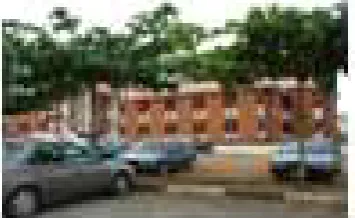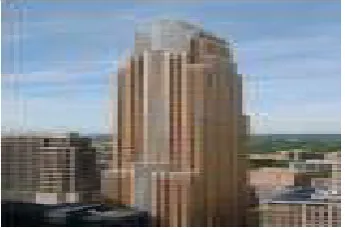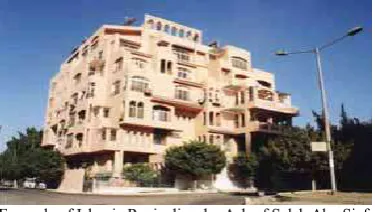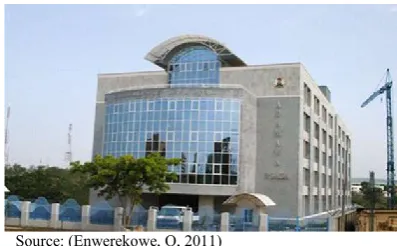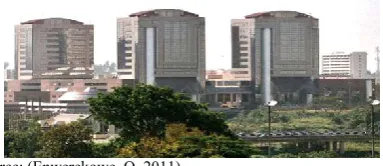POSTMODERNISM ALTERNATIVE TO LOW CARBON ARCHITECTURE
*Mobark Mohamed Osman Mohamed
Department of Architecture, University of
ARTICLE INFO ABSTRACT
Evaluation of the environmental effects of the construction industry reveals that building contributes to the increasing proportion of carbon dioxide in the environment. With this backdrop, a stark redirection in design and construction approaches to mitig
carbon modern practice is urgent and imperative. This research work is aimed at introducing a new style of building design that integrates both vernacular and modern building materials in order to achieve the low car
literature survey. However, this study posits that postmodernism, which had its roots in historicism and straight revivalism, yet sought to humanize modern architecture by relating
larger physical and social context and re
for low carbon building designs. Moreover, the study pointed out that these vernacular materials should be re
cement. Other policy issues are discussed.
Copyright © 2015 Mobark Mohamed Osman Mohamed
unrestricted use, distribution, and reproduction in any medium, provided the original work is properly cited.
INTRODUCTION
Contemporary trends in architecture favour
environmental consciousness. With the recent increases in fossil fuel prices worldwide, coupled with climate change, global consciousness is awakened, especially in the architecture, to find solutions to these challenges. Recourse to this problem involves finding design alternatives that reduce carbon emissions. China for instance, loses 200 billion dollar annually as a result of pollution arising from airborne carbon exhaust intricately linked to construction (Beltran, 2011 study posits that postmodernism, which had its roots in historicism and straight revivalism, yet sought to humanize modern architecture by relating buildings to their larger physical and social context and re-establishing the use of traditional classical or vernacular lateritic material is recourse for low carbon building designs. However, this study points out that these vernacular materials should be re
post-modern form by integrating the literate with granulated tires and stabilized with cements.
Vernacular building Materials
The use of laterite predates 1807. Its red colour is attributed to the presence of high content of iron. Laterite is found in abundant in sub-tropical region which experience high rain
*Corresponding author: Mobark Mohamed Osman Mohamed
Department of Architecture, University of Bahri, Turkey
ISSN: 0975-833X
Article History:
Received 10th April, 2015
Received in revised form 25h May, 2015
Accepted 24th June, 2015
Published online 28th July,2015
Key words: Post-modernism, Historicism, Low carbon, Vernacular, Laterite.
Citation: Mobark Mohamed Osman Mohamed Current Research, 7, (7), 17996-18004.
RESEARCH ARTICLE
POSTMODERNISM ALTERNATIVE TO LOW CARBON ARCHITECTURE
Mobark Mohamed Osman Mohamed
Department of Architecture, University of Bahri, Turkey
ABSTRACT
Evaluation of the environmental effects of the construction industry reveals that building contributes to the increasing proportion of carbon dioxide in the environment. With this backdrop, a stark redirection in design and construction approaches to mitigate the adverse effects of existing pro carbon modern practice is urgent and imperative. This research work is aimed at introducing a new style of building design that integrates both vernacular and modern building materials in order to achieve the low carbon benchmark. The methodology adapted in this research work was based on literature survey. However, this study posits that postmodernism, which had its roots in historicism and straight revivalism, yet sought to humanize modern architecture by relating
larger physical and social context and re-establishing the use of traditional laterite material is recourse for low carbon building designs. Moreover, the study pointed out that these vernacular materials should be re-interpreted in modern form by integrating the laterite with granulated tires stabilized with cement. Other policy issues are discussed.
Mobark Mohamed Osman Mohamed. This is an open access article distributed under the Creative Commons Att use, distribution, and reproduction in any medium, provided the original work is properly cited.
sustainability and environmental consciousness. With the recent increases in fossil fuel prices worldwide, coupled with climate change, global consciousness is awakened, especially in the architecture, to find solutions to these challenges. Recourse to is problem involves finding design alternatives that reduce carbon emissions. China for instance, loses 200 billion dollar annually as a result of pollution arising from airborne carbon Beltran, 2011). This y posits that postmodernism, which had its roots in historicism and straight revivalism, yet sought to humanize modern architecture by relating buildings to their larger establishing the use of rnacular lateritic material is recourse for low carbon building designs. However, this study points out that these vernacular materials should be re-interpreted in modern form by integrating the literate with granulated
The use of laterite predates 1807. Its red colour is attributed to the presence of high content of iron. Laterite is found in
tropical region which experience high rain
Mohamed Osman Mohamed
Department of Architecture, University of Bahri, Turkey.
fall, and found in large quantities in Africa, Australia, India, South East Asia and South America. (
Laterite Reinforced with Granulated tyres
Utilization of granulated tyres as stabilising material, has become quite popular in recent years, especially in earth and rammed earth building construction
However it has been established in literature that the addition 4% cement, and 4% granulated tyre to laterite as stabilised material can result to strength and durability equivalent up to 7% cement mixture to laterite (
assessment of the building construction industry in Europe postulated that mineral removed
as 4.8 ton per inhabitant per year, this, however is as much as 64 times the weight of an average person. In fact,
Lutz-Carillo (2009) reinforces the need for reduction in weighted building material in construction a
Earth sustainability. Granulated tyre as stabilised composition material proffers good solution to this challenge, due to the fact that rubber density is by far less than that of clay (
2015)
Compressed earth brick
Compressed Earth Block (CEB) is used in walls construction, to meet both structural performance and aesthetic. United Nations Organization and other NGOs encourages the use of
Available online at http://www.journalcra.com
International Journal of Current Research
Vol. 7, Issue, 07, pp.17996-18004, July 2015
INTERNATIONAL
Mobark Mohamed Osman Mohamed, 2015. “Postmodernism alternative to low carbon architecture z
POSTMODERNISM ALTERNATIVE TO LOW CARBON ARCHITECTURE
Evaluation of the environmental effects of the construction industry reveals that building contributes to the increasing proportion of carbon dioxide in the environment. With this backdrop, a stark ate the adverse effects of existing pro-carbon modern practice is urgent and imperative. This research work is aimed at introducing a new style of building design that integrates both vernacular and modern building materials in order to bon benchmark. The methodology adapted in this research work was based on literature survey. However, this study posits that postmodernism, which had its roots in historicism and straight revivalism, yet sought to humanize modern architecture by relating buildings to their establishing the use of traditional laterite material is recourse for low carbon building designs. Moreover, the study pointed out that these vernacular materials ern form by integrating the laterite with granulated tires stabilized with
is an open access article distributed under the Creative Commons Attribution License, which permits
fall, and found in large quantities in Africa, Australia, India, South East Asia and South America. (Lemougna et al., 2011)
Laterite Reinforced with Granulated tyres
Utilization of granulated tyres as stabilising material, has become quite popular in recent years, especially in earth-block and rammed earth building construction (Arayela, 200). However it has been established in literature that the addition nd 4% granulated tyre to laterite as stabilised material can result to strength and durability equivalent up to 7% cement mixture to laterite (Chee-Ming, 2007). An assessment of the building construction industry in Europe postulated that mineral removed for construction is estimated as 4.8 ton per inhabitant per year, this, however is as much as 64 times the weight of an average person. In fact, Brown and Carillo (2009) reinforces the need for reduction in weighted building material in construction as important of Earth sustainability. Granulated tyre as stabilised composition material proffers good solution to this challenge, due to the fact that rubber density is by far less than that of clay (Stephen,
h Block (CEB) is used in walls construction, to meet both structural performance and aesthetic. United Nations Organization and other NGOs encourages the use of
INTERNATIONAL JOURNAL OF CURRENT RESEARCH
laterite and local materials because they cost lower and are environmentally responsive to affordable housing (Lemougna
et al., 2011; Yomi Michael, 2012).
Lateriate bricks in wall construction
[image:2.595.344.518.51.156.2]Laterite bricks are an excellent construction material, has good thermal insulation properties, durability and compressive strength. Literate can be stabilized with cement, fiber, and granulated tyre. Hydra form block were widely used in residential, and public buildings in many cities in Nigeria, for instance in Lagos, Abuja, and Akure to enhance thermal performance of building interiors. Research have proved that hydraform has trice the efficiency of concrete block, and nearly twice the efficiency of fired clay bricks in its thermal insulation characteristics (Adedeji et al., 2010, www.hydraformnigeria. com).
Figure 1. School of Earth and Mineral Sciences, FUT, Akure. Use of Brick facing as Wall Finishing
[image:2.595.75.253.252.361.2]Source : ( www.mdpi.com/journal/sustainability)
Figure 2. Ikeja Plaza Building, Awolowo way, Ikeja. The use brick facing, recesses and horizontal
Wall constructed in earth, could be found in many cities across the Nigeria for instance in Abuja, Electronic Laboratory Hall in the Federal University of Technology Akure, and Obasanjo Estate in Ado-Ekiti. Moreover, constructed interlock laterite block could also be utilized as facing bricks. These earth materials are environmentally friendly, durable and required less maintenance (Ogunsote and Adedeji, 2012).
Source: (www.mdpi.com/journal/sustainability.)
Figure.3.(a) CEB construction in Cameroon; (b) Adobe construction in the USA
Moreover, they are good insulating materials, and provide optimum thermal comfort for building occupants. Walls constructed in laterite bricks can save cost, and improve aesthetic.
Characteristics of vernacular architecture
Term vernacular architecture refers to buildings, built by their dwellers, their design being influenced by climatic conditions, geographical location and cultures. It entails inherent undocumented knowledge on how to effectively utilize available materials to create conducive built environment, amenable to dwellers life style. With time, vernacular buildings proved to be sustainable and withstand all environmental challenges (Zhai, 2010).
Post- modernism
Modernism and postmodernism can be attributed to cultural orientation and tendencies in art, architecture, design (Shafique and Akhtar, 2012). Modernism started as international style in 1950s, and transformed to Postmodernism only in the 1970s. The style is marked by revival of ornamentation and humour, antithesis of plain and formal facades of modernism. The functional and simple form of Modernism is substituted by more aesthetical and complex forms and Architects rediscovered impressive and symbolic context in architecture and forms patterns (http://en.wikipedia.org/w/index.php? oldid=426755050). Moreover, Post -modernism is extravagant architectural style that was a reaction against modern architecture. It emphasis is that architecture should be expressive, symbolic, and experimented with abandoned architectural features such as Classicism, kitsch, eclecticism, and vernacularism (Nesbitt, 1996; Kahl, ?). Protagonist of Postmodernism includes Venturi whose work is an adaptation of symbolism in design was appreciated by many artist and observers who comprehended his traditionally inspired projects (Condorcet, 1955).
Samples of some prominent post-modern buildings:
[image:2.595.71.253.400.515.2][image:2.595.65.263.632.745.2]
Figure 5. Neue Staatsgalerie in Stuttgart, Germany by James Stirling and Michael Wilford, 1984
[image:3.595.78.251.212.327.2]Figure 6. Wells Fargo Center in Minneapolis by César Pelli. Completed 1988
Figure 7. Messeturm in Frankfurt, Germany By Helmut Jahn. Completed 1991
Historicism
According to, Condorcet (1955) historicism is a term applied to the behaviour and method of solving current problems and forecast the future on the basis of experience of past. Post-modern architects and artists recalled readapting history, which had been greatly neglected by modernist. Postmodernist in their effort to challenge the idea of originality followed the notions of recopying other famous architects and artists works with the intention of exposing them more in modernized manner (Nesbitt, 1996). Considering the architectural work of Swiss born Mario Botta, the past incorporates vital information, artefacts, original techniques and ideas that can aid architects in inventing modernized building expression that is quite acceptable in the contemporary time. In line with this he advocates that architects should carry on with using the previous work, not as pastiche, but they should rather be considered as guide to educate them about potentialities of contemporary time (Condorcet, 1955). Botta, also emphasised
that ’’It is the task of the architect, therefore, to re-create the
forms and memories of the past, in new and relevant ways’’
(Paine, 2012)
Examples of Postmodernism which are inspired by strip use in historical buildings:
(Photograph: Ashley Paine, 2010). Figure 8. Siena Cathedral, Siena, 13th-14th Century. (Photograph: Ashley Paine, 2012)
Figure 8. Mario Botta: Watari-um Art Museum, Tokyo, 1985-90
Vernacularism
This is broadly employed in architecture relating to tourism and culture. Since tourists needed to be provided with comfortable environment, readily available material which expresses local form, shape and folklores to reflect the identity of people living in that region are used. The success of this depends to great extent on the level of honesty of the designer to create simple design or highly expressive and monumental design. (Contemporary Architectural Expression, ?)
Historical revivlism
The post-modernism concepts evolution is to bridge the gap created by modernism, and these gap includes, the absence of interaction among building users, contextual, and the traditional meaning of built environment (Al-Lahham, 2014). Moreover, other authors have defined revivalism in architecture as the ’’ use of visual styles that consciously echo
the style of a previous architectural era’’ (Wikipedia, ?)
Historical revivalism is not a modern architectural fashion, and its presence dated back to European Renaissance. A good example of historical revivalism is the work of Egyptian architect, Farouk Algohary. He adapted internal courtyard system and used arches with orderly arranged in hierarchal order and stucco screen for windows. His intention of these is to portray the connection between contemporary and past as shown in the figure below. Another notable example is the work of another Egyptian architect Salah Abo Seif.
Example of Islamic Revivalism by Farouk Al Gohary
Figure 9. Oriental Weavers Headquarters, Heliopolis, Cairo
[image:3.595.330.532.581.731.2]Example of Islamic Revivalism by Ashraf Salah Abo Sief.
Figure 10. Apartment Building, Al Mokattam District, Cairo
In his attempt to portray Islamic culture and heritage in the Apartment Building Cairo, he harmonized the entire building envelope, and intentionally disregards utilization of any modern architectural visual elements. Instead he adapted dwarf arches and timber pergola, as shown in following figure (Salam, 2007)
Low carbon architecture
[image:4.595.33.290.353.436.2]Low carbon transformation can be comprehended as Greenhouse Gas emissions route that keep GHG concentration to a level that would not cause any hazard to the environment. Table I below show sample of gas and constituent carbon and carbon related gasses (Dhar et al., 2013).
Source: IPCC Fourth Assessment Report, Working Group I, table 2.14 (2007)
Building contributes invariably to the increase of green house gas emissions much more than any other sector of the economy. However, emissions resulting from building construction and use have escalated in recent years. The figure below explains green gas house effects (Ochsendorf, 2012).
Source: www.arcticportal.org/greenhouse-gases
Figure 11. The Greenhouse Effect
Concept of sustainability in vernacular architecture
The UNCED Brundtland Commission 1987 define sustainable architecture as building “that meets the needs of contemporary society without denying future generations of the ability to
meet their needs” (www.architecture.com/climatechange) Sustainable architecture in boarder sense is an appropriate utilization of our immediate environment without performing any dangerous activity that could endanger it , materials and energy should however be improved. The concept of sustainability is that our activities and action today on this planet shouldn’t cause a harm or constraint to the life of coming generations (Sirija, 2013). Sustainability can be viewed in vernacular architecture in the way it’s portrays mixture of climatic condition of a place, in other words, using available material at hand, with simple techniques to create interesting architecture that suit people life style and socio-economic condition of the region. In sustainability notions, analysing environmentally friendly characteristics of vernacular architecture gives a good basic knowledge to designers engaged in future design of sustainable built environment (Halıcıoğlu, 2012).
Carbon city design
Many world cities, such Tokyo, New York, London have accepted the notion of becoming low carbon. It has been reported that approximately 1050 cities in USA, 40 cities in India, and over 100 cities in China, have set up objective low carbon city plan to realize the goal of reducing carbon emission (Su et al., 2013) Low Carbon City can be defined as ’’ a city that comprises of societies that adapts sustainable green technology, green practices and emit relatively low carbon to avoid negative carbon impacts on climate change‘’ (http://esci-ksp.org/wp/wp-content/uploads/2012/04/Low-Carbon-Cities-Framework-and-Assessment-System.pdf).
There is urgent need for all countries of the world to create low carbon societies. This can be achieved only by adapting the following principles:
Minimizing carbon emissions in all sectors.
People should try and live simpler and rich life, in other word public should change from quantity consuming society to quality oriented one. These changes should be through consumer choice.
Coexistent with the natural environment, I.e. people should interact with environment in a manner not to cause any harm to it (https://www.env.go.jp/earth/info/pc071211/ en.pdf).
Source: https://www.env.go.jp/earth/info/pc071211/en.pdf.
Figure 12.Transportation in Low carbon city
[image:4.595.46.282.522.667.2] [image:4.595.314.554.568.716.2]
Post-Modernism and low carbon building
Post-Modermism as a style embracing plural approaches
According to Charles Siegel (2008) post-modernism based on architectural theory can be group into:
1- Avant-Gardism Architecture:-. The most popular protagonist of this idea is Peter Eisenman.
His most popular work figure --Wexner Centre, Frank GeharY - figure--, Daniel Libeskind - designed the Freedom Tower New York figure--
2- Humanist Architecture: - This school argued that all traditional buildings are based on patterns that gave them quality of being – ‘a life’ (Siegel, 2008). Robert Venturi in his book’ Complexity and contradiction in Architecture’ published in 1966, explored this life giving ideology and criticised the
[image:5.595.121.479.53.391.2] [image:5.595.139.462.415.610.2]Source: https://www.env.go.jp/earth/info/pc071211/en.pdf
Figure 14. Living scene in Low carbon city
Source ; https://www.env.go.jp/earth/info/pc071211/en.pdf
Figure 15. Industry in Low city carbon
modernist from two points; Firstly, because they opposed tradition, and secondly, however, they adapted rationality and excessive simplicity (Gelernter, 1995).
[image:6.595.67.263.97.234.2](Photograph by Mike Evteev)
[image:6.595.119.468.312.747.2]Figure 16. Peter Eisenman, Wexner Center (1989).
Figure 17: Frank Gehry, Stata Center (2004) (Photograph by Tjeerd Wiersma.)
Source: (wikipedia encyclopaedia)
Figure18. Freedom Tower New York
Post-modernism style of architecture have lent emphasis to comfort, traditional building and social life of building occupants, and these are manifested in historicism, straight revivalism and neo-vernacularism which entail marrying traditional concept of building with modern one (http:// sdngnet.com/Files/Lectures/FUTY-AR-403/Lecture%20Notes/ Modern%20Trends%20in%20Architecture%20070113g.pdf.).
Source:http://sdngnet.com/Files/Papers/Journal%20Publications/Classification%20of%20Nigerian%20Architecture.pdf.
However this give indication that post-modernism accepts any variant styles or concept, therefore, integrating vernacular building material in contemporary building for sustainable development can be achieved by integrating literate with granulated tyre and cement.
Northern Nigeria as a case study area
Breif history of Nigeria
Nigeria is the most populous country in Africa, according to 1993 census with a population estimated as 120 million. There are about 400 ethnic groups in Nigeria and more than 300 local dialects. The dominant tribes are Hausa, Yoruba and Igbo. The country was under British rule between (1861 to 1960) AD (Cordelia, ?).
Vernacular architecture of northern Nigeria
The most influential factors that affected architecture in northern Nigeria is the advent of Islam in Northern Nigeria, and the popular Brazilian styles; however North African influences on Northern Nigeria was as a result of the Sudanese styles. The interaction of traditional architecture with these historical architectural style generated vernacular (http:// sdngnet.com/Files/Papers/Journal%20Publications/Classificati on%20of%20Nigerian%20Architecture.pdf). Architecture of northern Nigeria
Case study of some post-modern buildings in Abuja
1-Adamawa plaza, Garki, Abuja
[image:7.595.334.533.90.213.2]Source: (Enwerekowe, O, 2011)
Figure 20. Adamawa Plaza Garki Abuja
Nigerian Communication commission headquarters,
Maitama, Abuja
[image:7.595.308.556.236.382.2]Source:(Enwerekowe, O, 2011)
Figure 21. Nigerian Communications Commission, Maitama, Abuja (front view)
S/No ITEM COMMENT
1 Location In Shagari Road Abuja, the building was commissioned in 2002
2 Designer El Mansur Atelier Co.
3 Plan Generated from African, rectangular form with central court yard.
4 Form The building is having covered atrium with translucent roof to enhancing interior lighting.
5 Finishes Exterior finishes are slate gray granite and mosaic tiles, and glazing, ceilings are suspended mineral acoustic fibre ceiling board.
6 Ornamentation Utilizes both traditional/cultural & international/ classical styles
7 Walls Characterized by interior ornamentations curtain glass wall & sleek-tilling. 8 Shadings Windows are recessed; provide both shading and aesthetically appealing.
S/No ITEM COMMENTS
1 Location Maitama, Abuja, was officially commissioned in2006
2 Plan The plan is circular based, asymmetrical, 10 storey building
3 Form It is elliptical form, with water fountain located in the central court yard covered with steel
girder roof trusses, giving sense of traditional form.
4 Shading Windows are recessed to provide shading with projected fins
5 Materials Modern material are married with traditional earth block
6 Ornamentations More or less symbolic to conform together to form dynamic timelessness.
7 Interior court yard system It is an Asian influences.
8 Steel roofing system This portrays a modern thatch roof.
S/No ITEM COMMENTS
1 Location Located on Herbert Macaulay way, in central business district, Abuja
2 Designer Designed by Sheltarc Associate, and constructed by Julius Berger Nigeria. PLC.
3 Form The four towers are symmetric but not similar. Buildings are rectangular with central
covered court yard
4 Walls Tinted reflected glass covered 80% of the entire building facade
5 Shadings Façade is protected by recessed
6 Design concept Glazed massive column in the four corner of the building are not constructional elements
but rather portrayed the significance oil sector in the economic of the nation
7 Ornamentations Four glazed column in the corner are for ornamentation purposes
8 Walls Reflective cladding on elevation portrayed Nigerian nation legacy’’ unity in diversity’’
Nigeria national petroleum corporation corporate headquarters, central business district, Abuja
[image:8.595.67.259.97.180.2]Source:(Enwerekowe, O, 2011)
Figure 22. NNPC, Headguarter
APPRISAL OF THE CASE STUDIES
Post-modern trend, just like its predecessors, it is not just a search for newly generated architectural patterns, but rather a finishing point in the for quest for absolutism, and tailored environment- an environment that majority of its designers, adjust their design and construction strategies in order to meet client needs and (Enwerekowe, 2007). Generally, numerous research proved that, laterite is more sympathetic to buildings users in the tropical region, as in northern Nigeria, which is characterized by hot humid to hot dry climate. Utilization of laterite stabilised with granulated tyre, compressed earth bricks and adobe is more appropriate for the fact that they are low carbon construction materials, having characteristics of being good thermal insulating material, and durable.
Having investigated some prominent headquarters buildings in Federal capital Territory Abuja, which represent post-modern architecture of Nigeria, it is imperative as to:
Integration of laterite bricks in the construction of walls for its good thermal insulation properties in these national buildings, by doing so, the public may patronize it and this will help in reducing the construction cost and reliance on cement and concrete. Hence reduces carbon dioxide emissions to achieve sustainable development and energy efficiency.
Utilization of laterite burned bricks as cladding material for building façade and as cladding for building shading devices to enhance building elevation. Moreover, the use of earth based roofing tiles materials are considered as environmentally friendly.
By adapting these laterite environmentally friendly material, by government and organization at national level, the public patronize it, thusly, bringing about entirely new post-modern style that incorporate both modern and traditional building material.
Conclusion
The contemporary architectural style of Nigeria documented in this research work is characterized as post-modernism. The introduction of new construction material and techniques, the vernacular architecture with its impressive ornaments is losing significance to post-modern style. In fact, the use of the popular vernacular courtyard system that was well appropriate to Northern Nigeria is currently downplayed and even where it was used, it has been covered with modern roof.
Thusly, architects should invent a new vocabulary, which adopts a unique architectural style sympathetic to people life style, culture and context. This would be achieved by marrying vernacular and post-modern material and techniques. Since Post-modernism recalls the significance of traditional architecture and classical vernacular in contemporary styles and plural approaches, it also recalls advantages of low carbon peculiarities of these materials. Moreover, government policies in tandem with these ideas are germane to its sustainability and low carbon environment.
Acknowledgement
I would like to acknowledge the instructor of the course Nazife Ozay, for her guidance to me during this research work, however, my thanks also goes to anybody who help me in one way or the other.
REFERENCES
Adedeji, Y. M., Aluko, O. Y. and Ogunsote, O. O. 2010.“Sustainable Landscaping and Green Housing in Tropical Climates: A Case Study of Akure, Nigeria”, In J.B. Olujimi,
Al-Lahham, A 2014. Traditionalism or Traditiona-lieism : Authentication or Fabrication? Arch-Net International
Journal of Architectural Research. Volume 8 - Issue 3 –
November (64-73) – Original Research Articles
Arayela, O. 2000. Development of stabilised laterite for building cost reduction in south western Nigeria. Unpublished PhD Thesis, Department of Architecture, Federal University of Technology Akure Nigeria.
Available at : http://espace.library.uq.edu.au/view/UQ:277624. Beltran, F. 2011. Is Zero Carbon Homes The Solutions? Chee-Ming, C. 2007. Strength and stiffness of
cement-stabilised laterite with granulated rubber addition. Proceedings of the Institution of Civil Engineers. 165,1,p. 41-52.
Condorcet, A .N 1955. Sketch of a Historical Picture of the Progress of Mind, tr. J. Barraclough, [S.I] Weidenfield and
Nicolson, pp 173
Contemporary Architectural Expression. Available at: http://archnet.org/system/publications/contents/3756/origin al/DPT0158.pdf?1384776583.
Cordelia, O. Osasona, C.O (n.d) From Traditional Residential Architecture to Vernacular: The Nigerian Experience. Faculty of Architecture. Obafmi Awolow University. Ile Ife. Nigeria.
Dhar, S., Pathak, M. and Shukla, P. R. 2013. Low Carbon City: A Guidebook for City Planners and Practitioners. UNEP Risø Centre on Energy, Climate and Sustainable Development Technical University of Denmark.
Enwerekowe, E. O. 2011. An Appraisal of Postmodernism in Nigeria (A case study of some selected buildings in Abuja, NigeriaURL.1. Hyraform New Information Package, 2009. Available at : www.hydraformnigeria.com.
Gelernter, M. 1995. Source of architectural Form: A critical history of Western design theory. Manchester University Press, Manchester and New york. Pp278-279
Kahl, D (n.d) Robert Venturi and His Contributions to Postmodern Architecture. Faculty History, Syracuse University
Lemougna, P. N. Chinje ,U. F. Kamseu, M. E. and Tchamba, A. B. 2011. Laterite Based Stabilized Products for Sustainable Building Applications in Tropical Countries: Review and Prospects for the Case of Cameroon. Open Access sustainability. ISSN 2071-1050 .Available at: www.mdpi.com/ journal/sustainability.
Nesbitt, K 1996. Postmodernism: Architectural Response to the Crisis within Modernism. Princeton Architectural Press, New York.
Ochsendorf , J 2012. Challenges and Opportunities for Low-Carbon Buildings. Published by the National Academy of Sciences.
Ogunsote, O. O and Adedeji 2012. Anticipated Contributions of Modern Building Materials to Sustainability: Climate Change Senario in Hot and Humid Regions of Nigeria. Dept. of Arch. Federal University of Technology, Akure.340001, Nigeria
Paine, A 2012. Botta’s Striped Historicism: Historicism, Myth and Fabulation in Mario Botta’s Stripes. School of Architecture, University of Queensland New Zealand Salam, A. M 2007. Mediterranean Visual Messages : The
conundrum of Identity, ISMS, and Meaning in Contemporary Egyptian Architecture. Arch net-IJAR,
International Journal of Architectural Research - Volume
1 - Issue 1 – March.
Shafique, M. and Akhtar, M. J. 2012. Limiting the Authority of Historical Knowledge’s: Post-modern Critique of ‘ Historicism’ and ‘ History’ . Pakistan Journal of Social
Science (PJSS) Vol.32. No 1, pp 137- 146.
Siegel, C. 2008. An Architecture for Our Time. The New Classicism. International Network for Traditional Building, Architecture and Urbanism (INTBAU). ISBN: 978-0-9788728-1-6.
Sirija, M. 2013. Necessity of Sustainability in Architectural Practices for Achieving Sustainable Development.
International Journal of Science and Technology Volume 2
No. 8.
Stephen, F. O (n.) Environmental and Cost Indices of Stabilized Laterite Composite in Re-Cycled Tyres in Buildings. A term paper submitted to Department of Architure, Federal University of Technology. Akure, Nigeria (Accessed 17-01-2015)
Su, M, Chen, C, Chen, B, Li, R. and Young, Z. 2013. Evaluation of a Low-Carbon City: Method and Application. Entropy 2013, 15, pp1171-1185; doi:10.3390 /e15041171. ISSN 1099-4300. Available at: www.mdpi.com/journal/ entropy.
Wikipedia, the free encyclopaedia. Available at: http://en.wikipedia.org/wiki/Revivalism_(architecture). Yomi Michael D. Adedeji , Olu Ola Ogunsote 2012.
Anticipated Contributions of Modern Building Materials to Sustainability: Climate Change Scenario in Hot and Humid Regions of Nigeria. Department of Architecture, Federal University of Technology, Akure, 340001, Nigeria. Zhai, Z and Previtali, J. M 2010. Ancient vernacular
architecture: characteristics categorization and energy performance evaluation. Energy and Buildings. Vol. 42, 357–365
URL.1. Hyraform New Information Package, 2009. Available at : www.hydraformnigeria.com.
URL.2. Post- modern Architecture Available at : http://en.wikipedia.org/w/index.php?oldid=426755050. (Accessed 12-01-2015)
URL.3. Climate Change Toolkit : Principles of Low Carbon Design and Refurbishment: Available at: www.architecture.com/climatechange. ( Accessed 16-01-2015)
URL.4. Low carbon cities : Framework & Assessment system.2011
Available at: http://esci-ksp.org/wp/wp-content/uploads/2012/ 04/Low-Carbon-Cities-Framework-and-Assessment-System. pdf. (Accessed 16.01-2015)
URL.5. Building a Low Carbon Society First Draft . Ministry of the Environment, Japan
December.2007. Available at: https://www.env.go.jp/earth/ info/pc071211/en.pdf. (Accessed 15-01-2015)
URL.6. Modern Trends in Architecture. Available at:
http://sdngnet.com/Files/Lectures/FUTY-AR-403/Lecture%20Notes/Modern%20Trends%20in%20Archit ecture%20070113g.pdf.
URL.7. Classifications of Nigerian Architecture. Available at: http://sdngnet.com/Files/Papers/Journal%20Publications/Cl assification%20of%20Nigerian%20Architecture.pdf.
